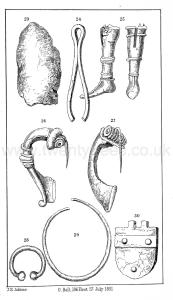Bronze Age Artefacts
Bronze Age Artefacts is in Metal Prehistoric Artefacts.
Books, Prehistory, Metal Prehistoric Artefacts, Bronze Age Artefacts, Brass Pin ![]()
Colt Hoare 1812. No. 16 [Map]. This, and the preceding barrow, both for superiority of size, and elegance of form, may be justly considered as the two finest tumuli in this group: they stand so contiguous to each other, that their circumvallation somewhat interfere. The first mentioned, is 89 feet in base diameter, and 14 feet in elevation: the one, now the object of our inquiry, measures in its base diameter 112 feet, and about 15 feet in elevation. On making our section, we were surprised to meet with a large and heavy piece of fossil wood, of a calcareous nature, resembling a bunch of twigs. I cannot learn that there is any substance of the kind in this neighbourhood, and I am sure the earth of which the barrow is composed, could never have generated it. At the depth of nearly 15 feet, and immediately under the spot where the fossil wood was found, we came to a shallow oblong cist, in which a skeleton had been deposited within the rude trunk of an elm-tree1, with its head lying to the north-east, On the left side of the head, a beautiful urn had been deposited, but crushed to pieces by the heavy pressure of earth upon it. We were however fortunate in collecting sufficient fragments to enable Mr. Crocker to make out an exact drawing of its and outline. (Tumuli Plate XV.) This sepulchral urn is different both in shape and colour to any we have ever found in the British sepulchres. It resembles in tint the fine red Samian pottery, and appears to have been turned in a lathe; the form of the neck is neat, and the five handles are like those we see on the Roman vessels; yet with all these appearances, we have one criterion to judge by, which, I think, will prove it ta be of British manufacture, viz. that it is not more than half baked, and the fractures discover a black and sooty appearance within, not having been burned in a kiln, like the pottery of the Romans. Near the breast of the skeleton, lay the brass dagger No. 2. which had been guarded by a case of wood, part of which appeared to have been highly ornamented, as we found a bit of wood near it that had indentations which certainly had been gilt. The handle seems to have been made of box wood, and rounded somewhat like that of a large knife, Near it lay a brass pin with an ivory handle, No. g. On the same side, but near the thigh, was a fine spear-head of brass, No, 4, very perfect, and most elegantly moulded, (for I have no doubt of these articles having been cast in moulds), and another article or ivory. The rich contents of this tumulus has induced us to crown it with royal honours, and to give it the title of KING BARROW. I have often been asked, if the largest barrows were not found, on opening, to be the most productive in their contents? The question is very natural, and I have rather wished to second that supposition; but as yet I have not a basis for that hypothesis. In the present instance, indeed, there is some ground for the above remark.
Note 1. The knots and bark adhering to the tree, we were able to ascertain with certainty its distinct species some naturalists, however, suppose, that the elm was introduced from the Continent into England. at a comparatively modern period.
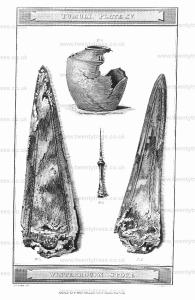
Colt Hoare 1812. No. 25 [Map] is a large and rude bowl-shaped barrow, 107 feet in diameter, and 6 in elevation. Its surface being uneven, we were led to suppose it had been opened. In making a large section into it, the workmen threw out the bones of several dogs, and some of deer, and on the floor found a human skeleton, which had been originally interred from north to south, but many of the bones had been displaced, probably owing to a recent interment of burned bones, which had been deposited near the feet of this skeleton. On the right side of its head were two small earthen cups, one of which was broken; the other preserved entire; the first, though of rude materials, and scarcely half burned, was very neatly ornamented; the other, is of a singular form and pattern: it is of a yellowish colour, and perforated in several places. Near these, cups was a curious ring or bracelet of bone or ivory, stained with red, which was unfortunately broken into several pieces. With the above articles were two oblong beads made from bone, and two whetstones; one of the silicious kind, almost as fine as a hone, and neatly formed; the other, of a fine grained white silicious stone. Near the above were brass pin, a pair of petrified fossil cockle shells, a piece of stalactite, and a hard fiat stone of the pebble kind, such as we frequently find both in the towns; as well as in the tumuli of the Britons.
Colt Hoare 1812. No. 42 [Map]. Nearly opposite the last mentioned barrow, but on the south side of the turnpike road; is a neat circular tumulus, sixty-six feet in diameter, and six feet in elevation, which was opened in 1803, and produced within a circular cist, an interment of burned bones, and a brass pin with part of its handle, deposited in a neat and perfect urn; the latter of which is engraved in Tumuli Plate XVI.
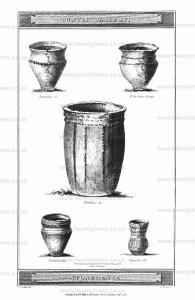
Colt Hoare 1812. No, 48 [Map], a Druid barrow, contained an interment of burned bones, with a brass pin.
Colt Hoare 1812. No. 83 [Map] contained a sepulchral urn, with a small brass pin.
Colt Hoare 1812. No. 131 [Map] had been opened by the neighbouring farmers. In this barrow we found, in a deep cist, an unusually large quantity of burned bones, and with them two drinking cups, two incense cups, and two brass pins. One of the incense cups was preserved entire, and is engraved of the original size in TUMULUS Plate XXIV. The quantity of bones, and the duplicate articles would induce me to suppose that this mound was raised over the relicks of two persons.
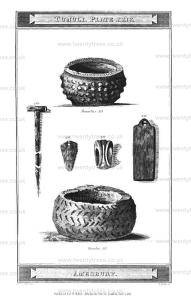
Colt Hoare 1812. No. 10 [Map] was opened by Mr. Cunnington in the year 1804. In its form, it resembles the second class of Druid Barrows, is neatly ditched round, having the vallum without, and the tumulus rising gradually to its apex from the ditch. It contained an urn inverted over the burned bones, which had been wrapped up in a linen cloth, to protect them; and with the bones were found a small brass pin, employed probably for fastening the cloth, five rings of a dark brown colour, one of which was perforated for suspension, (Tumuli Plate XIII.) a small cone of the same materials perforated also for the same purpose, and several pully beads of glass, with one of jet, and another of amber.
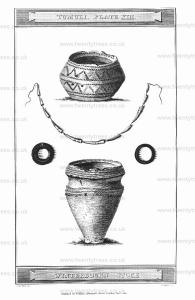
Books, Prehistory, Metal Prehistoric Artefacts, Bronze Age Artefacts, Bronze Awl ![]()
Bronze Awl. A woodworking or stiching hand tool for making small holes
Throwley. 18th August, we opened a barrow [Throwley Moor Barrow [Map]] on the hill behind Throwley Moor House, the dimensions of which are not ascertainable, from the greatest part of the mound being natural. We commenced digging on the north-west side, through earth one foot deep, beneath which was rock. We soon, however, arrived at a flat stone, placed upright beneath a wall that crossed the barrow; and having removed sufficient of the latter to allow us to proceed, found immediately below its foundation a large sepulchral urn, which, contrary to general usage, stood with the mouth upwards in a hole in the rock eighteen inches deep; the upper edge, from having been long exposed to the influence of the atmosphere from being so near the surface, was so much disintegrated as to be at first taken for charcoal, but we ascertained the diameter to be about fourteen inches; it is quite plain, and composed of coarse friable clay, of a brick red outside and black within. It contained calcined human bones, amongst which were the following articles - two fine pins, made from the tibia of an animal probably not larger than a sheep; a short piece cut from a tubular bone, and laterally perforated, possibly intended for a whistle; a bronze awl, upwards of three inches long, which has been inserted into a handle, and is now covered with a very dark and polished aerugo; a flint spear head; and a bipennis, or double-edged axe, of basaltic stone. All these, except the whistle and the awl, have been submitted to the fire, by which the axe had been so much injured that it was difficult to extricate it from its position under the bones at the bottom of the urn without its falling to pieces. The urn itself, being very thin and adhering to the rock, was taken out in small fragments. The few stone axes found during our researches have uniformly been associated with the brazen daggers, and were replaced by the plain axe-shaped celt at a slightly later period, but in no other instance have they accompanied an interment by cremation; indeed the instances in which the brass dagger has been found with burnt bones bear so small a proportion to those in which it accompanies the skeleton, that we may conclude there was a marked, though gradual change in the mode of burial introduced about the time when the knowledge of metallurgy was acquired. There is, however, evidence that the ancient rite of burial was resumed at a later period, dating but little, if at all, previous to the occupation of the country by the Romans.
Hill Head. In the afternoon we opened another barrow [Staker Hill Barrow [Map]] to the west of the last, on Stakor Hill, which at first appeared nothing more than a natural ridge of rock, terminating with a rounded end rather higher than other parts; but on cutting down in the centre, it was found to be a barrow, and that it had been disturbed thereabout. A grave, about a yard deep, had been cut in the rock, and roughly walled round, and had contained at least two skeletons. By removing one of the wall stones, we found a small bronze awl, similar to several others in the collection at Lomberdale House [Map], which had been inserted into a wooden handle as a tool for piercing skins or leather. The grave extended to the north, where it was both deeper and undisturbed, as we found a third skeleton lying at the bottom, having under the head a thin instrument of white flint that had been intensely burnt, but destitute of any other accompaniment except animal bones, which were plentiful in both tumuli.
Youlgrave. On the 3rd of May, we made a second investigation of the tumulus at Bee Low [Map], near Youlgrave, which was first imperfectly opened by us in 1843, the excavation being then confined to the centre; but the mound being a bowl-shaped one, upwards of twenty yards diameter, it was thought worth while to make a further trial in it, which was begun by digging from the old cutting in the middle to the south side. The first discovery made when we had proceeded about three yards, was a skeleton lying on its left side with the knees drawn up, and the head to the east, so that the face was turned to the outside of the barrow. It was about eighteen inches below the surface of the mound, and did not seem to have been placed in a cist, although two or three courses of flat stones were carefully laid over it: near the head were three small instruments of bronze, two of them awls, and a few bits of the same metal that had been melted, and which had originally been small instruments of similar character. This skeleton having been taken up, we perceived the ground on the right or western side of the trench to decline; following this indication, we came to an irregular grave cut in the rock, the bottom about 4 feet 6 inches from the surface of the barrow: it was surrounded by a lining of small flat stones placed on edge, and within this lining was a regular pitching, like a street pavement, of clear chert stones very closely packed, extending over the whole grave; above them earth and stones had been thrown in without' order, but underneath them was the skeleton of a young person resting in the usual contracted position, with the head to the south-west, the elbows almost in contact with the thigh bones, and the hands in front of the face. At the angle formed by the bending of the knees, was a beautiful drinking-cup, only 6½ inches high, ornamented by two variations of the lozengy pattern; it still retained its upright position, and close to it was a very fine instrument of white flint, upwards of four inches long, which may have been used either as a knife or saw. While tracing out the western extremity of this grave, our attention was drawn to a very large stone, set up in a direction from S.E. to N.W., on a little higher level than the bottom of the grave, which was at length found to be one end of a rectangular cist, the other sides and cover of which were formed of similar slabs. Its internal dimensions were 3 feet 6 inches long, 2 feet wide, and 3 feet deep; and it was filled with stiff earth and small gravelly stone, amongst which, near the top, were fragments of calcined bone, and a small bronze awl or pin; removing the earth down to the floor (which was rock), we there found the bones composing the skeleton of an aged man, with a short round cranium, carefully placed in a heap in the middle, the long bones laid parallel with each other, and the skull put at the top of the heap, with the base upward. The bones being perfect, it is evident that this arrangement had been made whilst they were fresh and strong; and it is not a little singular that a similar mode of interment exists among the Patagonians, who make skeletons of their dead previous to burial. After removing these bones we found two small flints, and a piece of stag's horn at the bottom. Great quantities of rats' bones were found through the whole of the excavation, but they were observed to be most abundant and best preserved around the second interment, with which, it may be proper to mention, there was a single piece of an infant's skull, no other of its bones being found by a most careful examination. The accompanying plan represents the position of the various interments in the barrow; the flat stone shewn with burnt bones in the centre, being found in 1843.

Waggon Low. On the 25th of June, we proceeded to the top of a hill near High Needham, called Waggon Low [Map], where we found some indications of an artificial mound, the dimensions of which could not be ascertained, on account of the numerous rocky protuberances around it. By excavation, we found that several interments had been placed between the masses of rock, which had originally been covered by the mound. The first discovered lay on its left side upon the rock, at the South side of the barrow, at the depth of about eighteen inches from the surface, with the knees drawn up, and the head towards the S.W.; immediately in front of this skeleton were two iron knives, respectively 5¼ and 8⅛ inches long, lying in contact with each other; there were also several tips broken from the tines of stags horns, some other imperfect animal bones, and part of a quern, which had been used as a sharpening stone, in the vicinity of the skeleton, which was that of an aged person, one of whose legs had been fractured, and reunited immediately above the ankle. Pursuing the excavation towards the north, the rock was found to have been cut out to the further depth of 18 inches, so as to form a large irregularly shaped grave; at the end nearest the first discovered skeleton, there was a large stone, under which was a deposit of calcined bones, accompanied by a small arrow-point of flint, and a rude instrument of bone, and in an angle of the rock close by, was a small vase of coarse clay, slightly ornamented, 4½ inches high. Next to this deposit were the bones of a full-grown person and an infant, both much decayed, but we considered the former to have been laid with the head to the east, they were destitute of relics, and were very imperfect, though they did not appear to have been disturbed. Immediately in contact with them, we observed the feet of another skeleton, which being carefully uncovered, was seen to lie on its right side, with the legs gathered up, and the skull to the north; at the right shoulder were three instruments of light-coloured flint and a small bronze awl, 1½ inch long, tapering each way from the middle, which is square - also the leg bone of a dog. The skeleton is that of a young person slightly above the middle height, the jaws containing the full number of teeth, which are but little worn; it is in beautiful preservation, and having been articulated, is preserved in a glass case at Lomberdale [Map]. Two flat stones were set up on edge behind it in the barrow, and it was imbedded in earth, to which it owed its preservation. During the progress of these researches, we observed the ground at the west side of the trench to have been disturbed yet lower, but were unable to follow up the indication, from the approach of evening; therefore, on the 28th of June, we again visited the spot, and after removing stone to the depth of 4 feet 6 inches, found that the grave assumed the shape of the letter L the lower limb representing the western portion, now under examination, where we discovered the skeleton of a good sized man of middle age, lying on his left side with the knees drawn up, and the head towards the west, embedded in tenacious clay, above which was a thick layer of charcoal. The whole grave was carefully cleared out to its extremest limits without further result, except the discovery of numerous rats' bones, and of occasional portions of those of larger quadrupeds, such as horses' and swine's teeth.
 Bateman's original notebook on display at Weston Park Museum, Sheffield.
Bateman's original notebook on display at Weston Park Museum, Sheffield.
Books, Prehistory, Metal Prehistoric Artefacts, Bronze Age Artefacts, Bronze Celt ![]()
Bronze Celt. A bronze tool similar to an adze, hoe, or axe.
Colt Hoare 1812. No. 158 [Map]. Though Dr. Stukeley has given an engraving of this tumulus, under the title of BUSH BARROW, it does not appear that he ever attempted open it. It was formerly fenced round and planted with trees, and its exterior at present bears a very rough appearance from being covered with furze and heath. The first attempts made by Mr. Cunnington on this barrow proved unsuccessful, as also those of some farmers, who tried their skill in digging into it. Our researches were renewed ill September, 1808, and we were amply repaid for our perseverance and former disappointment. On reaching the floor of the barrow, we discovered the skeleton of a stout and tall man lying from south to north: the extreme length of his thigh bone was 20 inches. About 18 inches south of the head, we found several brass rivets intermixed with wood, and some thin bits of brass nearly decomposed. These articles covered a space of 12 inches or more; it is probable, therefore, that they were the mouldered remains of a shield. Near the shoulders lay the fine celt1 Tumuli Plate XXVI. No. 1, the lower end of which owes its great preservation to having been originally inserted in within a handle of wood. Near the right arm was a large dagger of brass, and a spear-head of the same metal, full thirteen inches long, and the largest we have ever found, though not so neat in its pattern as some others of an inferior size which have been engraved in our work. These were accompanied by a curious article of gold, which conceive had originally decorated the case of the dagger, Tumuli Plate XXVII, No. 1. The handle of wood belonging to this instrument, No. 2, exceeds any thing we have yet seen, both in design and execution, and could not he surpassed (if indeed equalled) by the most able workman of modern times. By the annexed engraving, you will immediately recognize the British zigzag, or the modern Vandyke pattern, which was formed with a labour and exactness almost unaccountable, by thousands of gold rivets, smaller than the smallest pin. The head of the handle, though exhibiting no variety of pattern, was also formed by the same kind of studding. So very minute, indeed, were these pins, that our labourers had thrown out thousands of them with their shovel, and scattered chem in every direction, before, by the necessary aid of a magnifying glass, we could discover what they were; but fortunately enough remained attached to the wood to enable us to develop the pattern. Beneath the fingers of the right hand lay a lance-head of brass, but so much corroded that it broke to pieces on moving. Immediately over the breast of the skeleton was a large plate of gold, Tumuli Plate XXVI. in the form of a lozenge, and measuring 7 inches by 6. It was fixed to a thin piece of wood, over the edges of which the gold was lapped: it is perforated at top and bottom, for the purpose, probably, of fastening it to the dress as a breast-plate. The even surface af this noble ornament is relieved by indented lines, checques, and zigzags, following the shape of the, outline, and forming lozenge within lozenge, diminishing gradually towards the centre. We next discovered, on the right side of the skeleton, a very curious perforated stone, some wrought articles of bone, many small rings of the same material, and another article of gold Plate XXVII, No 3, 4, 5. The stone is made out of a fossil mass of tubularia, and polished; rather of an egg form, or as a farmer who was present, observed, resembling the top of a large gimlet. It had a wooden handle, which was fixed into the perforation in the centre, and encircled by a neat ornament of brass, part of which still adheres to the stone. As this stone bears no marks of wear or attrition, I can hardly consider it to have been used as a domestic implement, and from the circumstance of its being composed of a mass of seaworms, or little serpents, I think we may not be too fanciful in considering it an article of consequence. We know, by history, that much importance was attached by the ancients to the serpent, and I have before had occasion to mention the veneration with which the glain nadrogth. was esteemed by the Britons; and my classical readers will recollect the fanciful story related by Pliny on this subject, who says, that the Druid's egg was formed by the scum of a vast multitude of serpents twisted and conjured up together. This stone, therefore, which contains a mass of or little serpents, might have been held in great veneration by the Britons, and considered of sufficient importance to merit a place amongst the many rich and valuable relicks deposited in this tumulus with the body of the deceased.
1. The word CELT has been applied to instruments of a very different form as well as composition, and has been written, engraved, and published concerning them. In the fifth volume of the Archæologia, we find a dissertation on them by Mr. Lort. accompanied by numerous engravings describing their different forms, some few of which resemble those that we have discovered; but one only is recorded a having been found in a Long barrow near Stonehenge by Dr. Stukeley, and rot recorded as a certainty. Much conjecture and debate have been employed by various authors respecting the original use of this instrument. Mr. Thoresby, in a letter to the celebrated antiquary Thomas Hearne, supposes them to have been heads of spears: or walking staves of the civilized Britons; but this opinion is rejected by Hearne, who thinks they were chissels used b the Romans for cutting and polishing stones. A curious inscription at Pola, in Istria, ascertains hat the word celtis denoted a chissel or graving tool, "Neque hic atramentum, vel papyrus, aut membrana ulla adhuc, sed malleolo et celie literatus silex, [Cruterus page 329]. Dr. Borlase also, in his Antiquities of Cornwall, page 281, has given an account of several brass Celts found in that county, together with an engraving. He supposes them to have been offensive weapons, and to have been made and used by the Romanized Britons. Dr. Stukeley attaches a degree of religious authority to them, by supposing that they were used by the Druids for cutting the mistletoe. These instruments differed in their construction, and in point of antiquity, l must give the priority of age to those discovered in our barrows, of which I am enabled to produce four specimens. The first engraved ia Tumuli Plate XXI is highly interesting, and shews the mode which the brass instrument was inserted in the handle. The second, engraved in Plate XXVI. is of a much larger size, but also had its handle; as well as two others engraved in subsequent plates, which, though smaller, resemble the others in form. I am obliged, from conviction, and from the strong evidence afforded by this handle, to differ from the learned antiquaries who have delivered their opinions on this subject. I cannot, with Mr. Thoresby and Dr. Borlase. suppose them to have been spear-heads, or offensive weapons; neither can I agree with the laborious antiquary, Thomas Hearne, in supposing them edge-tools for cutting stones, the metals of which they are formed are soft for such a purpose; neither can we find the edges furrowed and scratched by hard usage; nor can my antiquarian zeal and enthusiasm persuade me to coincide, in this instance, with the Druidical system of Dr, Stukeley. They appear to me to have been instruments used for domestic, not for mihitary, architectural, or purposes. These appear also to have been the first models, from which the pattern with sockets for the insertion of a handle was taken; for amongst the numerous specimens described by Mr. Lort in the Archæologia, not one of the latter pattern is mentioned as having been discovered in a barrow. As many similar instruments have been found in Gaul, and have been noticed by and Caylus, I cannot attribute the sole manufacture of them to Britain, but rather suppose they imported thither from the mother country on the continent; or perhaps the art of making them might have been introduced. One circumstance, I think, appears evident and conclusive viz. that the earliest pattern, and which probably gave rise to the larger and more ornamented one, was that described in four instances as having been discovered amongst other sepulchral deposits in British tumuli. The celts of flint, engraved in Tumuli PlateS V, VI. were evidently used for chipping stone or other materials, of which I can adduce a curious proof, by the circumstances attending discovery of one of these articles, which is now in my possession. Some workmen in cutting a canal, near Stockbridge, found several of these flint Celts dispersed about the soil, and deposited near the rude trunk af a tree, which was intended to have been fashioned by their means into a boat or canoe.
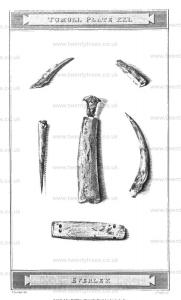
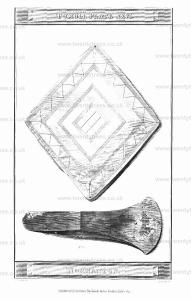
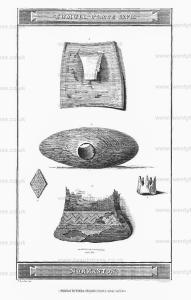
Section I Tumuli 1843. 4th of September, 1843, a small barrow, about two miles south of Middleton-by-Yolgrave [Map], named Borther Lowe [Map], was investigated, first by digging down the centre, and afterwards by cutting it through to the south side. In the first excavation pieces of urns, horses' teeth, and other bones were immediately found. Proceeding lower down, upon the level of the ground on which the barrow was raised, a rude kind of pavement of rough limestones was found, which was covered with a layer of rats' bones. Yet no human bones were discovered in this part of the mound, which was therefore abandoned, and the south side subjected to an examination, with better success. The ground on the south being removed to the depth of a foot, a skeleton, with the head lying towards the interior of the barrow, was uncovered. It was found to be in a very decayed state, from its being placed so near the surface, within the influence of the atmosphere. On the left side of the skeleton were the remains of a plain, coarse urn, much disintegrated, owing to the reason above stated, a flint arrow-head, much burnt, a pair of the canine teeth of either a fox or a dog of the same size, and a diminutive bronze celt. The contemporary use of weapons of flint and bronze is remarkable: in another place are a few observations bearing upon this point. In other parts of the tumulus were three hones of fine slatestone. In an adjoining field are the remains of another barrow, removed in order to supply materials for a stone fence at the least expense; but there are no records of any discovery of interments having been made at the time.
Thomas Bateman 1845. 02 Jun 1845. On the 2d of June, 1845, was opened a large and well-known barrow called Moot Lowe [Map], which is situate about half way between Alsop Moor and Dovedale; it is a large tumulus, about thirty yards in diameter, and about four feet in height, being perfectly level on the top, which is planted with large trees. On digging through the centre a large cist was discovered which was cut in the rock, having, on account of the dip of the strata, a sloping floor; at the west end of the cist and upon the lowest part of the slanting floor lay the skeleton of a middle-sized man, whose legs were drawn up; near his head lay a fine bronze celt of novel form; it was placed in a line with the body, with its edge upwards. The lower jaw of a small pig was also found close to the skeleton. At the other extremity of the cist, which was near five yards from the situation of the last-described interment, were found the skeleton either of a female or young person, and a few burnt bones, which had been disturbed and thrown together in a heap at some remote period, as the overlying soil was as firm aud solid as in any other part of the tumulus. During the progress of the excavation there occurred part of the antler of a deer, some horses' teeth, and their usual concomitant, rats' bones.
Shuttlestone near Parwich. On the 3rd of June we examined a mutilated barrow in a plantation upon Parwich Moor, called Shuttlestone [Map], which had originally been about four feet in height; it consisted of a compact mass of tempered earth down to the natural surface of the land, below which point, in the centre of the barrow there appeared a large collection of immense limestones, the two uppermost being placed on edge and all below being laid flat, though without any other order or design than was sufficient to prevent the lowest course resting upon the floor of the grave, inside which they were piled up, and which was cut out to the depth of at least eight feet below the natural surface; thus rendering the total depth from the top of the mound to the floor of the grave not less than twelve feet. Underneath the large stones lay the the skeleton of a man in the prime of life and of fine proportions, apparently the sole occupant of the mound, who had been interred whilst enveloped in a skin, of dark red colour, the hairy surface of which had left many traces both upon the surrounding earth and upon the verdigris or patina coating a bronze axe-shaped celt and dagger, deposited with the skeleton. On the former weapon there are also beautifully distinct impressions of fern leaves, handsful of which, in a compressed and half-decayed state, surrounded the bones from head to foot. From these leaves being discernible on one side of the celt only, "whilst the other side presents traces of leather alone, it is certain that the leaves were placed first as a couch for the reception of the corpse with its accompaniments, and after these had been deposited, were then further added in quantity sufficient to protect the body from the earth. The position of the weapons with respect to the body was well ascertained; and is further evidenced by the bronze having imparted a vivid tinge of green to the bones where in contact with them. Close to the head were one small black bead of jet and a circular flint; in contact with the left upper arm lay a bronze dagger with a very sharp edge, having two rivets for the attachment of the handle, which was of horn, the impression of the grain of that substance being quite distinct around the studs. About the middle of the left thigh bone was placed the bronze celt, which is of the plainest axe-shaped type. The cutting edge was turned towards the upper part of the person, and the instrument itself has been inserted vertically into a wooden handle by being driven in for about two inches at the narrow end - at least the grain of the wood runs in the same direction as the longest dimension of the celt, a fact not unworthy of the notice of any inclined to explain the precise manner of mounting these curious implements. The skull, which is decayed on the left side, from the body having lain with that side down, is of the platy-cephalic form, with prominent parietal tubers - the femur measures 18½ inches.
Readon Hill. September 4th, opened a barrow nineteen yards diameter and three feet high, on Readon Hill [Possibly Wredon Hill Barrow [Map]], near Ramshorn, which is mentioned by Plot, Hist. Staff, fol. 1686, p. 404. It contained two skeletons extended at length, about the centre, without any protection from the earth of which the mound was formed, with the exception of a few stones in contact with one of the bodies, which was possibly interred at a subsequent period to the other, as it was not more than two feet from the surface of the barrow, whilst the other lay on the natural level, at least three feet from the turf covering the mound. Vestiges of the hair of the former were perceptible about the skull, which was that of a young man, and in perfect preservation; and a small pebble was found at the right hand (compare Barrow [Map] opened 30th May, 1845, Vestiges, p. 67). The other, and probably earlier interment, was covered with a thin layer of charcoal. The skull is that of a middle-aged man, the vertex much elevated, the left side completely decayed from lying in contact with the floor of the barrow. At some distance from either of the skeletons, but nearest to the higher interment, from which, however, they were full two yards, lay an iron spear, thirteen inches long, with part of the shaft remaining in the socket, and a narrow iron knife, eight inches in length. An examination of these by the microscope, enables us to add the further information that the spear has been mounted on an ashen shaft, about one inch of which yet remains, owing its preservation to being saturated by the ferruginous matter produced by the decomposition of the iron - outside the iron are numerous casts of grassy fibre, and the larvae of insects, apparently flies - the grass must have been present at the time of interment in considerable quantity. The knife shews fewer traces of the vegetable, and more of the animal structures, the tang where inserted into the handle, shews the impression of horn. It is fortunate that metals in a state of oxydization have the property of taking, and retaining, the most delicate casts of substances the most perishable with which they lie in contact; we thus gain much valuable information as to the materials of dress in times of pre-historic antiquity, and are enabled to describe the circumstances under which the dead were committed to the grave, with an exactitude resulting from a strictly inductive method of reasoning. For example, we find that the early Celtic population, whose chief men were armed with the bronze celt and dagger, not only wore the skins of animals during life, but were enveloped in the same after death, and were thus laid upon a bed of moss or fern, before being buried out of the sight of their friends beneath the sepulchral mound. In later times, when the use of iron became so general as to supersede the more ancient metal bronze, we find a corresponding advancement in the materials of clothing, the impression of woven fabrics, of varying degrees of fineness, being almost invariably distinguishable on the rust of weapons found in the barrows; although the old custom of providing a grassy couch for the remains of the deceased was still retained, from an intuitive feeling beautifully expressed by Sir Thomas Browne, in his Hydriotaphia, when referring to the sepulture of the ancients, he writes - "that they have wished their bones might lie soft, and the earth be light upon them. Even such as hope to rise again would not be content with central interment, or so desperately to place their reliques as to be beyond discovery, and in no way to be seen again; which happy contrivance hath made communication with our forefathers, and left unto our view some parts which they never beheld themselves."
On the following day we examined another barrow in the same neighbourhood, about 21 yards diameter. It is called Wardlow, and is constructed over a lump of rock, in the middle of which was cut a grave, which we found had been previously disturbed, it had originally contained a skeleton with burnt bones, and chippings of flint. A cutting through the side of the mound where there was the greatest accumulation of factitious earth, produced many fragments of human bone, together with those of the water rat.
Books, Prehistory, Metal Prehistoric Artefacts, Bronze Age Artefacts, Bronze Pin ![]()
Section I Tumuli 1825. The only barrow yet discovered in a low situation in the neighbourhood of Middleton is placed in a meadow called Larks Lowe [Map], and near the rivulet called the Bradford; this tumulus was opened on the 20th of May 1825 when the cist was found to be constructed of large flat stones placed edge-ways with similar ones serving for the cover; it contained the decayed fragments of a human skeleton. On the eastern side of the barrow was found an urn of coarse earthy full of calcined bones and dry mould, the top protected by a flat piece of lime-stone, upon which was placed a small, shallow, earthen vessel very firmly baked, (of the kind denominated by Sir Richard Hoare (age 66) "incense cups"), a pin of bronze, two and a quarter inches long; several animal teeth and bones, amongst them a horse's tooth, a circular pebble, and a stone of peculiar shape; the large urn was of so friable a nature, that it probably had no other baking than what it received in the funeral fire, from this cause it was found impracticable to preserve it entire. June 19, 1826, it was thought advisable to reopen the very interesting barrow [Map] on Garratt Piece, Middleton, which was opened by Dr. Pegge in 1788, and described in the Archæologia, vol. ix, page 189; in it were found animal bones, one of which was calcined; a portion of the lower branch of an antler of the red deer, six inches in length, which had been tooled at the root by a sharp instrument; also some rats' bones. (See a subsequent examination of this barrow.)
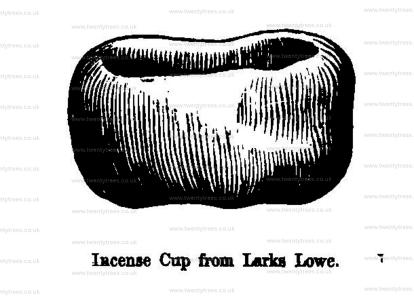
Thomas Bateman 1846. Upon a more complete investigation of this barrow (on the 23d of August, 1847) another interment was discovered in a similar cist on the opposite side of the mound, as was anticipated on the previous occasion. The mode of burial was in each case similar both bodies having been laid at a depth of nine feet from the summit, and covered with numerous large stones. In this instance the skeleton lay on the left side, in a contracted position, with one aim beneath the head, and near the thigh-bones were found a neatly-chipped spear-head of gray flint, and a small bronze pin, which had been inserted into a wooden handle.
Nothing else worthy of notice occurred in the progress of the excavation.
Throwley. On the 10th of February, we investigated a tumulus [Possibly Cart Low [Map]] midway between Throwley and Calton, 17 yards across and 3 feet high, wholly composed of earth of a burnt appearance throughout The principal interment was found about a yard from the centre, and consisted of a deposit of large pieces of calcined human bone, which lay within a circular hole in the natural soil, about a foot deep, of well defined shape, resulting from contact with a wooden or wicker work vessel, in which the bones were placed when buried, the vestiges of which, in the form of impalpable black powder, intervened between the bones and the earth. Upon the bones lay part of a small bronze pin, and a very beautiful miniature vase, of the "Incense Cup" type, 8⅛ inches high, 3½ diameter, ornamented with chevrons and lozenges, and perforated in two places at one side. Among the bones were two small pointed pieces of flint, and a common quartz pebble; and below the deposit was the shoulder-blade of a large animal, which has been designedly reduced to an irregular shape by the use of flint saws, or otlier instruments equally inefficient. At one side of this interment, were four other deposits of calcined bone, placed on the floor of the mound, here of rock, intersected by veins of clay, without any protection from cist or urn, but evidently deposited at one and the same time, as the heaps were quite distinct and imdisturbed, though very near to each other. They had been so thoroughly calcined as to be comminuted, and had almost reached the inevitable catastrophe of "dust to dust,"
Ten Years' Digging 1849 Hurdlow. On the 7th of July we opened the first of a line of three small tumuli, occupying the summits of hills between the Buxton and Ashbourne road and the village of Church Sterndale. The field in which it is placed is called "Top of the Hurst". The mound, about 12 yards across, and not more than a foot high, consisted of earth, tempered in that part immediately above the grave, which was so far sunk into the rock as to render its floor rather more than two feet below the turf. It was cut nearly east to west, and contained a skeleton extended at length, with the head to the latter point; the lower bones were fairly preserved, but of the upper parts there were but few remains, the enamel crowns of the teeth being in the best condition. At the left hip was a small iron knife, 4 inches long; and where the right shoulder had been was an assemblage of curious articles, the most important of which was a small bronze box, or canister, with a lid to slide on, measuring altogether 2 inches high and the same in diameter. When found it was much crushed, but still retained inside remains of thread, and bore on the outside impressions of linen cloth. Close to it were two bronze pins or broken needles, and a mass of corroded iron, some of which has been wire chainwork connected with a small bronze ornament with five perforations, plated with silver and engraved with a cable pattern, near which were two iron implements of larger size, the whole comprising the girdle and chatelaine with appendages, of a Saxon lady. Many pieces of hazel stick were found in contact with these relics, which were probably the remains of a basket in which they were placed at the funeral All the iron shows impressions of woven fabrics, three varieties being distinguishable, namely, coarse and fine linen, and coarse flannel or woollen cloth. The box is very faintly ornamented by lozenges, produced by the intersection of oblique lines scratched in the metal and may be compared with one found at Stand Low in 1845 (see Vestiges, p. 75).
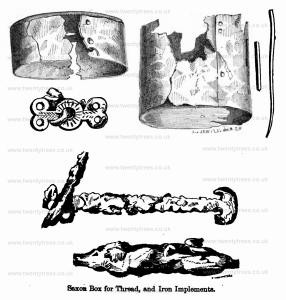
Youlgrave. On the 3rd of May, we made a second investigation of the tumulus at Bee Low [Map], near Youlgrave, which was first imperfectly opened by us in 1843, the excavation being then confined to the centre; but the mound being a bowl-shaped one, upwards of twenty yards diameter, it was thought worth while to make a further trial in it, which was begun by digging from the old cutting in the middle to the south side. The first discovery made when we had proceeded about three yards, was a skeleton lying on its left side with the knees drawn up, and the head to the east, so that the face was turned to the outside of the barrow. It was about eighteen inches below the surface of the mound, and did not seem to have been placed in a cist, although two or three courses of flat stones were carefully laid over it: near the head were three small instruments of bronze, two of them awls, and a few bits of the same metal that had been melted, and which had originally been small instruments of similar character. This skeleton having been taken up, we perceived the ground on the right or western side of the trench to decline; following this indication, we came to an irregular grave cut in the rock, the bottom about 4 feet 6 inches from the surface of the barrow: it was surrounded by a lining of small flat stones placed on edge, and within this lining was a regular pitching, like a street pavement, of clear chert stones very closely packed, extending over the whole grave; above them earth and stones had been thrown in without' order, but underneath them was the skeleton of a young person resting in the usual contracted position, with the head to the south-west, the elbows almost in contact with the thigh bones, and the hands in front of the face. At the angle formed by the bending of the knees, was a beautiful drinking-cup, only 6½ inches high, ornamented by two variations of the lozengy pattern; it still retained its upright position, and close to it was a very fine instrument of white flint, upwards of four inches long, which may have been used either as a knife or saw. While tracing out the western extremity of this grave, our attention was drawn to a very large stone, set up in a direction from S.E. to N.W., on a little higher level than the bottom of the grave, which was at length found to be one end of a rectangular cist, the other sides and cover of which were formed of similar slabs. Its internal dimensions were 3 feet 6 inches long, 2 feet wide, and 3 feet deep; and it was filled with stiff earth and small gravelly stone, amongst which, near the top, were fragments of calcined bone, and a small bronze awl or pin; removing the earth down to the floor (which was rock), we there found the bones composing the skeleton of an aged man, with a short round cranium, carefully placed in a heap in the middle, the long bones laid parallel with each other, and the skull put at the top of the heap, with the base upward. The bones being perfect, it is evident that this arrangement had been made whilst they were fresh and strong; and it is not a little singular that a similar mode of interment exists among the Patagonians, who make skeletons of their dead previous to burial. After removing these bones we found two small flints, and a piece of stag's horn at the bottom. Great quantities of rats' bones were found through the whole of the excavation, but they were observed to be most abundant and best preserved around the second interment, with which, it may be proper to mention, there was a single piece of an infant's skull, no other of its bones being found by a most careful examination. The accompanying plan represents the position of the various interments in the barrow; the flat stone shewn with burnt bones in the centre, being found in 1843.

Books, Prehistory, Metal Prehistoric Artefacts, Bronze Age Artefacts, Bronze Spear Head
Diary of a Dean by Merewether. 12. An urn of usual dimensions, 7 inches high, found in a barrow of low elevation, a short distance south of a remarkable long barrow, already described as made up of circular and convex sarsen stones, to the south of Kennett, at the feet of a skeleton lying towards the west, and in a regularly-formed cist.
13. A bronze spear-head, found with the above, 4 inches long.
14. A stone hatchet of compact bluish stone, resembling lias, also in the same, five inches long.
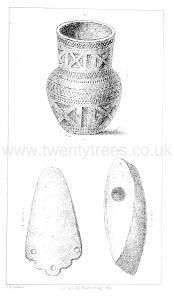
Diary of a Dean by Merewether. 19. Horseshoe found a short distance north-west of Silbury Hill, with other horseshoes, and a skeleton.
20. Bronze spear-head found in digging flints in the down south-west of Beckhampton, with back earth round it, but without any irregularity of ground. Full size of original, as are the following, to No. 33.
21 and 22. Bone pins found in digging flints on the same down.
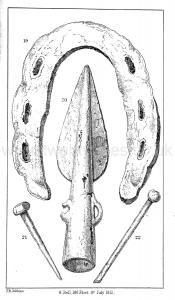
Diary of a Dean by Merewether. 23. Bronze spear-head found with No. 11.
